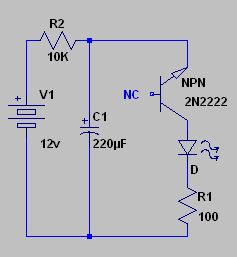Simple LED Flasher Project
I wanted to put together a simple two LED flasher circuit that would use the fewest parts and low power. My first project of this type used the NE555 timer IC but besides the chip, it requires more power than what I would like to use. Using a couple low-power NPN transistors, the circuit should be able to run for hours on a 9v battery.
The Circuit
I decided to use two 2N3904 transistors (a low power NPN transistor). This design uses only 10 components but I added additional resistor to inline with the power source. It could be removed and the other resistors adjusted to lower the power.

I used a free copy of LTSpice from Linear Technology to create the circuit (most SPICE packages do not have LED components for some reason) – you can download it here: http://www.linear.com/designtools/software/ltspice.jsp
Which LED will light first?
The Breadboard
I assembled the circuit using a low cost breadboard I picked up at Fry’s Electronics. Using a breadboard allowed me to play around with different components, especially the capacitors and resistors to tweak the flash rate and brightness.

Single LED Flasher
The simplest single LED Flasher circuit I have found uses a single transistor (NPN), 2 resistors and 1 capacitor. This circuit uses the transistor as a Negistor using the NDR (negative differential resistance) effect. The transitor will block current until the voltage threshold charging on C1 reach something close to 9v, at which point the voltage will become large enough to get the emitter-base junction to avelanche and drain the current through the LED.

Click here for the video:
http://jasonacox.com/images/IMG_2022.MOV
Reference
http://wild-bohemian.com/electronics/flasher.html
http://en.wikipedia.org/wiki/2N3904
http://www.linear.com/designtools/software/ (LTspice – Nice circuit design tool based on Spice)
http://jlnlabs.online.fr/cnr/negosc.htm
http://www.cappels.org/dproj/simplest_LED_flasher/Simplest_LED_Flasher_Circuit.html
